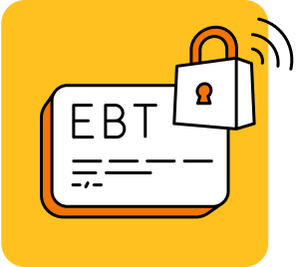How are EBT benefits being stolen?
Unfortunately over the past few years EBT benefits theft has been affecting more and more people.
EBT benefits theft with the physical card (lost or stolen card)#ebt-benefits-theft-with-the-physical-card-lost-or-stolen-card
Until recently, EBT theft generally happened when the physical card was taken by someone else.
For example, if someone gives their card and PIN to another person, that person can spend and possibly steal the benefits.
Or if someone writes their PIN number on the card to avoid forgetting it but then loses it, anyone who finds that card could spend the benefits because the PIN is right there.
Electronic EBT theft: a new trend#electronic-ebt-theft-a-new-trend
The main reason EBT theft has spiked so much in the last few years is that criminals have started stealing benefits electronically.
What does that mean?
Electronic EBT benefits theft is when criminals steal benefits by taking the electronic information on a card — the EBT card number and PIN — and spend the benefits with that information.
With electronic theft, the thief does not need to take the physical EBT card itself to steal the benefits.
Many victims are shocked when they discover their benefits have been stolen, often by seeing they only have a few cents left on their balance or noticing large transactions they didn't make.
They're surprised because their EBT card is still in their wallet!
So how does electronic EBT theft happen? There are a few different ways.
1. EBT theft from card skimming#1-ebt-theft-from-card-skimming
EBT card skimming happens when a criminal puts a small device on the EBT point-of-sale (POS) machine that you swipe your card in to spend your benefits at a grocery store or other EBT-accepting retailer.
When you swipe your card, this device (called a card skimmer) secretly records your EBT card number and PIN as you enter it. With this information, thieves can spend your benefits by creating a duplicate of your card (“cloning”) or by spending your benefits online.
For more information on how card skimming happens, see how does EBT card skimming happen?
2. EBT theft from phishing or scamming#2-ebt-theft-from-phishing-or-scamming
Phishing is when a criminal tricks someone into giving up sensitive information by pretending to be someone else in a text, email, phone call, etc.
For EBT theft, a common phishing scam is when thieves send out bulk text messages to people saying their EBT card is locked, and give a phone number to call to “unlock” the card.
When the victim calls that number, they are asked to enter their EBT card number and PIN number. Remember: someone asking for your PIN number is a big red flag! Once the thieves have this information, they can steal the benefits.
Similar phishing scams can happen with deceptive e-mails, websites, or phone calls that look and sound official but are actually stealing your benefits. Remember: Your state’s EBT agency will never ask for your PIN via text or phone!
Scamming is when someone tricks you into giving your EBT card and PIN number and then uses that information.
For example, never give your PIN number to an employee at a retail store. Only enter it yourself on the EBT machine. Although this is not common, if a store employee has your card number and PIN, they could use that information to spend your benefits without you knowing.
Card cloning#card-cloning
Card cloning is when thieves use your EBT card number and PIN to make a fake card. They don’t need your physical card to spend your benefits.
If a scammer has stolen your card information with skimming or phishing, card cloning is how they create a card to use in the store.
Other forms of electronic EBT theft#other-forms-of-electronic-ebt-theft
Unfortunately, even though EBT criminals are being investigated and prosecuted, people who receive EBT are still getting their benefits stolen.
Thieves often change their methods. Recently, some EBT users have reported that their PIN numbers were changed by someone else, and then their benefits were stolen.
Unlike card skimming and phishing, it’s unclear how this is happening, but it shows the importance of staying aware and protecting your personal information, including your EBT card number and (especially!) your PIN.
